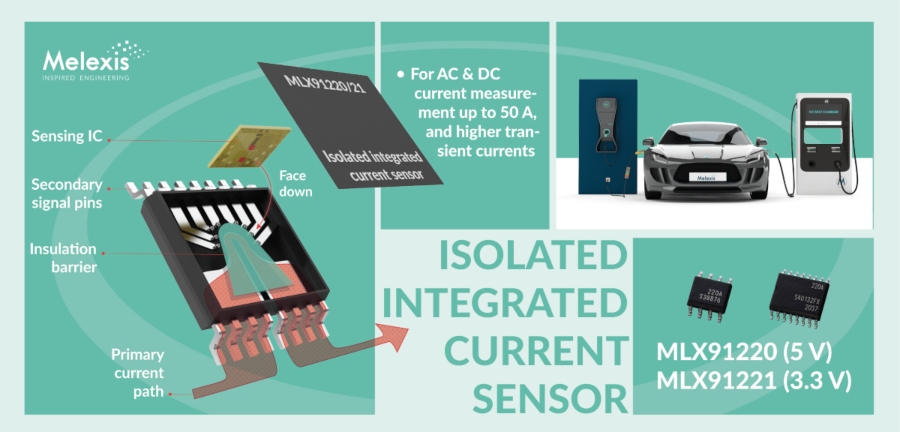Melexis presenta la próxima generación de sensores de corriente integrados aislados para aplicaciones de automoción

La solución monolítica todo en uno aumenta el rendimiento y reduce la complejidad del diseño
Tessenderlo, Bélgica, 7 de diciembre de 2020 - Melexis, una empresa mundial de ingeniería microelectrónica, anuncia su segunda generación de sensores de corriente integrados aislados MLX91220 (5 V) y MLX91221 (3,3 V). Los sensores de corriente basados en el efecto Hall están cualificados para su uso en una serie de aplicaciones industriales y de automoción, como cargadores de a bordo (OBC), convertidores CC/CC, fuentes de alimentación y pequeños accionamientos eléctricos. Con un ancho de banda de 300 kHz, se adaptan a una variedad de aplicaciones de conversión de energía inferiores a 50 A RMS.
El MLX91220/21 se basa en la primera generación de sensores de corriente, que integraron elementos de detección y acondicionamiento de señal de alta precisión con aislamiento de tensión. Los sensores de corriente de nueva generación, que están disponibles en encapsulados miniatura SOIC8 de cuerpo estrecho y SOIC16 de cuerpo ancho, mejoran esto al aumentar el ancho de banda a 300 kHz, lo que resulta en un tiempo de respuesta de sólo 2 us. Este tiempo de respuesta soporta frecuencias de conmutación más altas y un seguimiento más preciso en los bucles de control.
El MLX91220 también mejora la función de detección de sobrecorriente en el chip (OCD) dual, que permite mecanismos de monitorización esenciales utilizando tanto una característica interna como externa. El umbral interno de OCD puede seleccionarse dentro o fuera del rango, con un tiempo de respuesta de 2 µs. El umbral de OCD externo puede fijarse, mediante un voltaje de referencia externo, dentro o cerca del rango de funcionamiento de salida, con un tiempo de respuesta típico de 10 µs.
Ambos pueden utilizarse en una aplicación, para ofrecer redundancia o detectar condiciones separadas de cortocircuito y fuera de alcance.
El MLX91220 y el MLX91221 ofrecen una flexibilidad de modo de salida definida en la fábrica de Melexis. Las aplicaciones de automoción suelen preferir los voltajes de salida analógicos ratiométricos, mientras que las aplicaciones industriales a menudo dependen de una sensibilidad fija construida en torno a un voltaje de referencia. El modo de salida se ajusta en fábrica y se puede seleccionar con códigos de pedido de producto intuitivos.
A diferencia de la mayoría de los sensores actuales, el MLX91220/21 no depende de concentradores ferromagnéticos. En su lugar, utiliza un concepto de detección diferencial interna para detectar el campo magnético generado por el conductor primario integrado. Este concepto diferencial también proporciona un alto nivel de inmunidad a los campos parásitos, lo que permite una electrónica de potencia de mayor densidad, ya que el sensor se ve menos afectado por los campos magnéticos parásitos de las proximidades.
El encapsulado SOIC8 tiene una capacidad de aislamiento de 2,4 kVrms según IEC/UL-62368, y el encapsulado SOIC16 de cuerpo ancho duplica esta capacidad de aislamiento de 4,8 kV. El encapsulado SOIC16 también ofrece una menor resistencia del conductor primario, gracias a su mayor número de pines y al aumento del grosor del conductor. Ambas variantes se distinguen de las soluciones de derivación discretas por tener una resistividad más baja, el SOIC16 tiene muestra 0,75 mOhm, mientras que el SOIC8 mide 0,85 mOhm; significativamente más baja que las soluciones basadas en derivación.
La amplia integración de características y la flexibilidad de diseño que ofrecen los modelos MLX91220 y MLX91221 proporcionan a los clientes una ventaja competitiva cuando buscan optimizar el rendimiento utilizando un solo producto. Para ayudar a los clientes a simplificar el diseño y beneficiarse de las nuevas funciones, Melexis desarrolla continuamente nuevas tecnologías para mejorar su oferta actual de sensores.
Ya están disponibles muestras y un kit de desarrollo. Póngase en contacto con Melexis o con su representante local para obtener más información.

